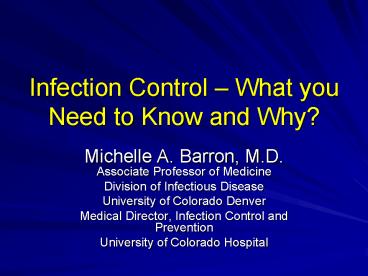Infection Control What you Need to Know and Why - PowerPoint PPT Presentation
1 / 19
Title:
Infection Control What you Need to Know and Why
Description:
Infection Control What you Need to Know and Why? Michelle A. ... Boyce ICHE 1997 18:622. Microorganisms Survive on Surfaces. Acinectobacter 3 days 5 months ... – PowerPoint PPT presentation
Number of Views:101
Avg rating:3.0/5.0
Title: Infection Control What you Need to Know and Why
1
Infection Control What you Need to Know and Why?
- Michelle A. Barron, M.D.Associate Professor of
Medicine - Division of Infectious Disease
- University of Colorado Denver
- Medical Director, Infection Control and
Prevention - University of Colorado Hospital
2
Hand Hygiene Works!
- Hand contamination after patient contact (A) and
after washing with an alcohol based sanitizer (B)
NEJM. 2009
3
Glove Contamination Occurs Regardless of Patient
Contact (n38)
Boyce ICHE 1997 18622
4
Microorganisms Survive on Surfaces
- Acinectobacter 3 days 5 months
- C. difficile 5 months
- E. coli 1.5 hrs 16 months
- Enterococcus sp. 5 days - 4 months
- Pseudomonas 6 hrs 16 months
- S. aureus 7 days 7 months
- HIV gt 7 days
- HBV gt 1 week
- Influenza 1- 2 days
Kramer, A. et al. BMC ID 2006. 6130.
5
Multi-drug Resistant Organisms (MRO) Alert Program
6
Patient and HCW Safety Via Pt Labels
M00717807 V010000776
TEST,ABN 09/03/08
DOB04/22/23 85/M ICMRSA FSCMC
PTOUTPAT LCUMGF PROVSHEPHERD,KANDACE
L
7
Isolation Precautions
8
Which type of precautions should be instituted
for this patient with an infected Spider Bite?
9
Contact Precautions
- Private room
- Use of hand hygiene
- Gloves and gowns must be donned prior to entry
into patient room - Used to prevent spread of multi-drug-resistant
organisms - VRE, MRSA, MDR Acinetobacter, etc.
- Most GI tract pathogens (C. difficile)
10
What kind of precautions should be used for this
patient with cough, sore throat and flu-like
symptoms?
11
Droplet Precautions
- Isolation of patients infected with organisms
that can be transmitted via droplets that can be
generated by the patient during coughing,
sneezing, talking, or during procedures - Private room and a surgical mask must be used
before entering the room in addition to hand
hygiene - Used for Influenza, RSV, Neisseria meningitides
12
What kind of precautions should be used?
- 36 yo male from Ethiopia presents to the ED with
complaint of fevers, night sweats, cough, and a
30 lb weight loss over the last 3 months.
13
Airborne Precautions
- Isolation of patients with organisms that are
spread via airborne droplet nuclei lt5mm in
diameter - Patient must be in a private room and the
isolation area must have gt6-12 air changes per
hour under negative pressure - A N-95 mask must be worn by all persons entering
the room in addition to standard precautions - Used for M. tuberculosis, measles, and primary
infection with Varicella zoster virus
N-95 Mask
14
(No Transcript)
15
Catheter-related blood stream infection (CRBSI)
- Positive blood culture from a peripheral vein in
a patient with a catheter and clinical evidence
of infection (and no other apparent source) - Most hospital-acquired BSIs are related to
central venous catheter (CVC) use
16
How To Distinguish Between Pathogen and
Contaminant
- Look at the organism
- Look at number of positive cultures
- If only 1 of 2 bottles are positive with S.
viridans, CNS, enterococus, Bacillus, P. acnes,
etc., likely a contaminant - If 2 of 2 bottles positive, important to
determine if the they were drawn from two
separate sites - If from the same site, may represent
contamination - Fever without positive blood cultures DOES NOT
EQUAL a line infection
17
Elements of Central Line Bundle
- Hand Hygiene
- Chlorhexidine Skin Prep (CHG)
- Maximal Barrier Precautions
- Optimal Site Selection Use of Subclavian Vein
and avoidance of Femoral Vein if possible - Daily Review of Line Necessity
18
2009 Antibiogram Data
19
Infection Control Pager
- Available 24 hours a day
- 7 days a week
- (303) 266-2927



















![NOTE: To appreciate this presentation [and insure that it is not a mess], you need Microsoft fonts: PowerPoint PPT Presentation](https://s3.amazonaws.com/images.powershow.com/7012918.th0.jpg?_=20201123045)











